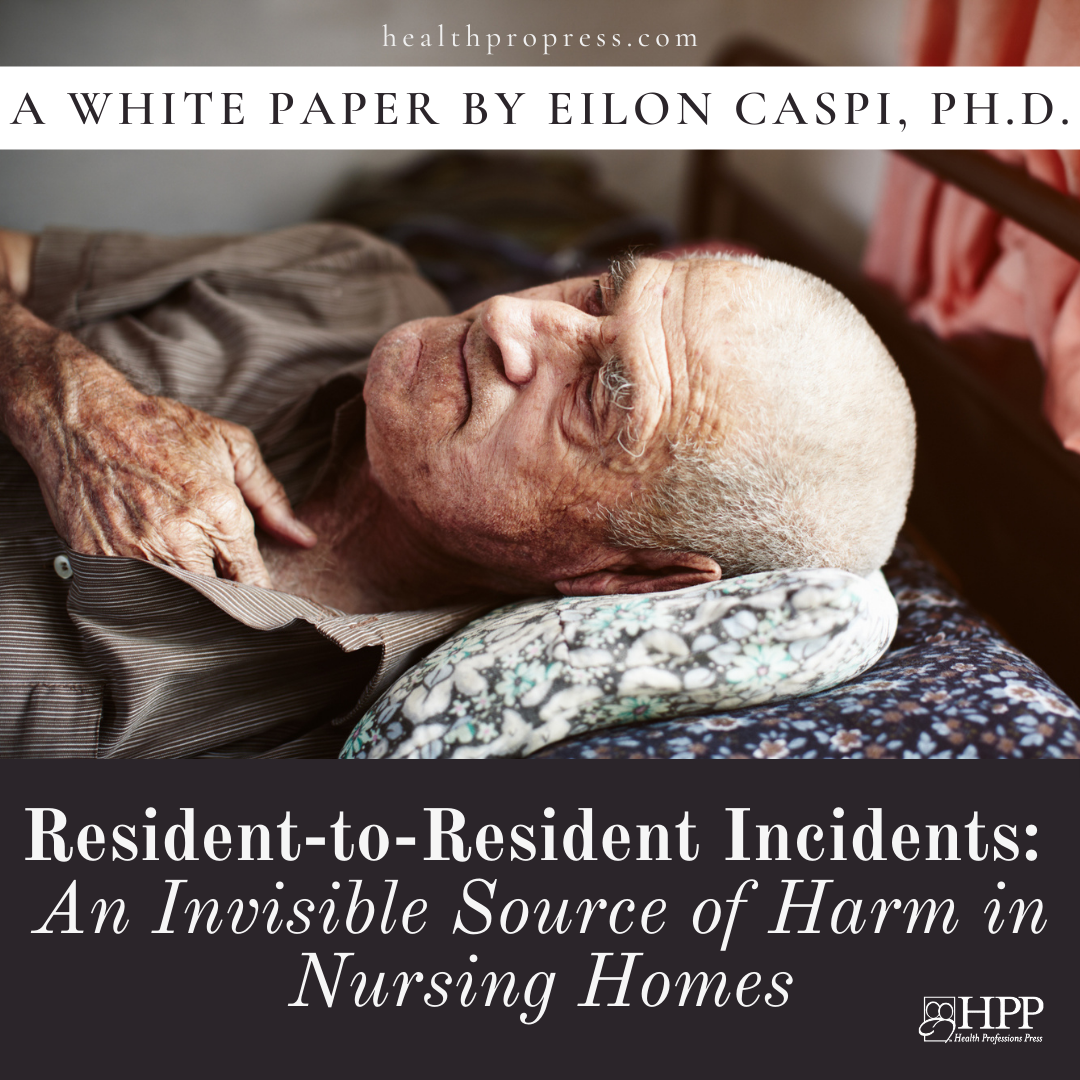
A White Paper by Eilon Caspi, Ph.D.
Dwayne E. Walls was an investigative reporter at The Charlotte Observer. Throughout his career, he wrote stories on social justice issues from the inner circles of the Ku Klux Klan and the homes of poor Black farmers; he also covered hunger, voter fraud and the dysfunctions of the coroner system. Some of his most compelling stories reported on challenges experienced by vulnerable populations. Late in his own life, he joined a different vulnerable population: elders living with dementia.
In 2001, Walls was diagnosed with Alzheimer’s disease. When his condition declined and his wife could no longer care for him at home, she moved him to a nursing home in South Carolina.
One evening, Walls walked into another resident’s bedroom and climbed into the empty bed. Moments later, the resident who lived in the room, an 88-year-old man with dementia, beat Walls with his cane. Walls was found severely injured, bleeding, and unconscious in a fetal position on the floor while the man continued to beat him. Walls died a week later.1
Resident-to-resident incidents (RRIs) in nursing homes have been shown in research to be prevalent,2 injurious,3 and, as in the case described above, occasionally deadly.4 One common definition5 of RRI is “negative, aggressive, and intrusive verbal, physical, material, and sexual interactions between long-term care (LTC) residents that in a community setting would likely be unwelcome and potentially cause physical or psychological distress or harm in the recipient.” Despite being prevalent and harmful to residents, such incidents remain underrecognized, understudied, untracked, and inadequately addressed in many nursing homes.
Two centralized mechanisms exist for the collection of data on these incidents, but so far they have not been utilized for this purpose: the F-tag system of the Centers for Medicare and Medicaid Services (CMS) and definitions used in the Minimum Data Set 3.0 (MDS 3.0). It is urgent that CMS and the Department of Health and Human Services (HHS) act to address these gaps in tracking.
Gathering the Right Facts
On July 13, 2019, the Government Accountability Office (GAO) published a report6 entitled Nursing Homes: Improved Oversight Is Needed to Better Protect Residents from Abuse. One of the recommendations made in the report was for the administrator of CMS to “require that abuse and perpetrator type be submitted by the state survey agencies in CMS’s databases for deficiency, complaint, and facility-reported incident data, and that CMS systematically assess trends in these data.” HHS, the government body overseeing CMS, concurred with this GAO “priority” recommendation. Two and a half years after the GAO made the recommendation, however, CMS has yet to implement it.
One reason the GAO recommendation is important is that the underlying causes of resident abuse by staff are usually very different from incidents that occur between residents. This is especially the case among residents with dementia. The ability to understand and address RRIs, therefore, remains limited if incidents involving resident harm are mostly classified broadly as “abuse.”
Two years before the 2019 GAO report, I published a journal article7 calling on CMS to bridge this major gap in oversight of approximately 15,000 nursing homes, where more than 1.2 million people live. The article identified 20 reasons why CMS tracking of RRIs could result in increased resident safety. Having studied this phenomenon for more than 13 years, I conclude that the story of RRIs among people living with dementia is largely one of neglect,8 the consequences of which can be as traumatic and devastating as those caused by staff abuse. Common risk factors that can lead to these episodes are low staffing levels, inadequate staff training, lack of risk assessment, inadequate care plans and biopsychosocial prevention strategies, lack of meaningful engagement, and problems in the physical environment that may limit staff ability to supervise residents with dementia and respond to their needs in a timely manner.
The F-tag citation for abuse
Each year, state survey agencies across the country complete thousands of standard inspections and complaint investigations in which state surveyors issue a deficiency citation (also called F-tag) for violations of federal nursing home regulations related to staff-to-resident abuse and RRIs. Currently, citations issued for these harmful incidents are commonly aggregated under the same F-tag type (F600, “Abuse”), which affords limited ability to distinguish between these two very different sources of harm and to track them separately. Violations related to RRIs could also receive a citation under F689, “Accident,” among other F-tags.
The lack of unique F-tags that distinguish between staff-to-resident abuse and RRIs represents a missed opportunity for learning and prevention. If CMS had a mechanism for tracking each of these unique sources of harm, the federal agency could have a centralized dataset of standard inspection and complaint investigation reports for separate analysis. This, in turn, would allow CMS to quickly and efficiently compile these invaluable reports and make them accessible to the public, researchers, care advocates, and policy makers, such as on the CMS Care Compare website9 and through Freedom of Information Act (FOIA) requests. I know the lack of access to such data from personal experience.
A few years ago, I submitted a FOIA request to CMS in which I asked to gain access to all standard inspection and complaint investigation reports containing citations related to RRIs over the previous 3 years. CMS responded that it was unable to compile and release these standard inspection and complaint investigation reports because the agency does not have a unique “regulatory group” for nursing home violations related to this phenomenon.
MDS 3.0 classification
In addition to the shortcomings of existing F-tags, the MDS 3.0, the largest federally mandated clinical dataset in CMS-certified nursing homes, does not capture the phenomenon of RRI (in Section E, “Behavior”). The MDS 3.0 does not distinguish between a resident’s “aggressive” behavioral expressions directed toward another resident (RRIs) and those directed from a resident toward staff. Nearly a decade ago, I published a letter to the editor10 in the Journal of the American Medical Directors Association about this gap in the MDS 3.0—a dataset routinely used by nurses and other care professionals in nursing homes to conduct comprehensive clinical assessment of every resident and his or her care planning. The extensive clinical data contained in the MDS 3.0 are regularly used in research studies, yet the absence of unique reporting fields for RRIs in the collected data represents a persistent barrier for researchers who want to conduct large-scale studies shedding light on risk and protective factors of this phenomenon.
State tracking in assisted living
The phenomenon of RRIs is also not being centrally tracked in assisted living residences11 (ALRs), which constitute the fastest growing residential care option for elders in the United States. ALRs are the homes of approximately 1 million people, 40–50% of whom are estimated to have a diagnosis of dementia. This oversight gap and barrier for learning exists despite large-scale research12 suggesting that RRIs may be prevalent in these settings. A study13 I conducted in secure dementia care homes operated within an ALR in Massachusetts showed that a significant portion of RRIs pose psychological distress and safety risks to residents with dementia. However, because ALRs are regulated at the state level and not by the federal government/CMS, they are not within the scope of this article—despite deserving equal attention.
Making the Invisible Visible
When a common, harmful phenomenon such as RRIs is not being tracked by CMS—both in its state survey regulatory system and the MDS 3.0—it remains invisible for all practical purposes. The federal agency is not in a position to learn from these incidents to inform policy or recommend care practice initiatives to address it. This missed opportunity was highlighted in 2018 when Karl Pillemer of Cornell University called for the development of a “comprehensive and data-driven national action plan”14 to address this phenomenon. Without basic national surveillance of this phenomenon by CMS and routine analysis of RRI–specific citations and MDS 3.0 data by the federal agency and researchers, the ability to develop and implement the sorely needed national action plan remains stymied.
My efforts over the years to encourage CMS to track and learn from these harmful incidents have yet to result in the needed changes. In 2018, I published the first U.S. study15 on fatal RRIs in the context of dementia. The study examined the circumstances surrounding the deaths of 105 elders as a result of these incidents. Two years later, a follow-up study4 by a group of researchers from Kent State University examined the circumstances surrounding the deaths of 101 nursing home residents. I hoped these two studies—along with the early Harvard study3 identifying a large number of physical injuries sustained by residents during these episodes in a single year in nursing homes in Massachusetts—would encourage CMS to finally pay close attention to this phenomenon, adequately track it, learn from harmful incidents, and develop meaningful large-scale initiatives to prevent them.
My letters to the U.S. Office of Inspector General and to the Centers for Disease Control and Prevention’s National Center for Injury Prevention and Control, asking the agencies to investigate and address this phenomenon, have gone unanswered. The release of studies demonstrating the concerning prevalence and harmful effects of this phenomenon as well as my own presentations about it at local, state, national, and international professional and scientific forums have so far not persuaded CMS to take action. It is worth pausing to consider: If these kinds of traumatic but preventable injuries and deaths occurred in childcare settings, our government agencies would not be allowed to remain so indifferent.
My attention has turned to public education in the hope of building greater awareness of this issue. In 2020, I co-directed with my colleague Judy Berry (CEO, Dementia Specialist Consulting) the first documentary film on injurious and deadly RRIs in LTC homes. In the 20-minute film Fighting For Dignity16,17 (Terra Nova Films), we interviewed three families whose loved ones were seriously harmed during these incidents. Our goal was to convey the emotional devastation these families experienced as a result of these episodes. Also, my book Understanding and Preventing Harmful Interactions Between Residents with Dementia18 (Health Professions Press, © 2022) has recently published. It is the first such resource dedicated solely to addressing these incidents and to informing LTC homes’ efforts to prevent these episodes to keep residents with dementia and care staff safe.
I urge HHS and the new administrator of CMS, Chiquita Brooks-LaSure, to implement the 2019 GAO “priority” recommendation. CMS, in its oversight of nursing homes, must be able to track and learn from violations of federal regulations related to RRIs and staff-to-resident abuse. The information exists; it only needs to be collected in a way that can be differentiated for what it is. Bridging these enormous gaps in data collection and tracking will ultimately enable vulnerable and frail elders to realize their human and, indeed, federal right to live in safe nursing homes.
DOWNLOAD A COPY OF THIS WHITE PAPER
Eilon Caspi, Ph.D., is a gerontologist and dementia behavior specialist. He is founder and director of Dementia Behavior Consulting, LLC, and a founding member, advisor, and board member of Elder Voice Family Advocates. He is an assistant research professor at the Institute for Collaboration on Health, Intervention, and Policy at the University of Connecticut.
Copyright © 2022 by Health Professions Press, Inc. All rights reserved.

